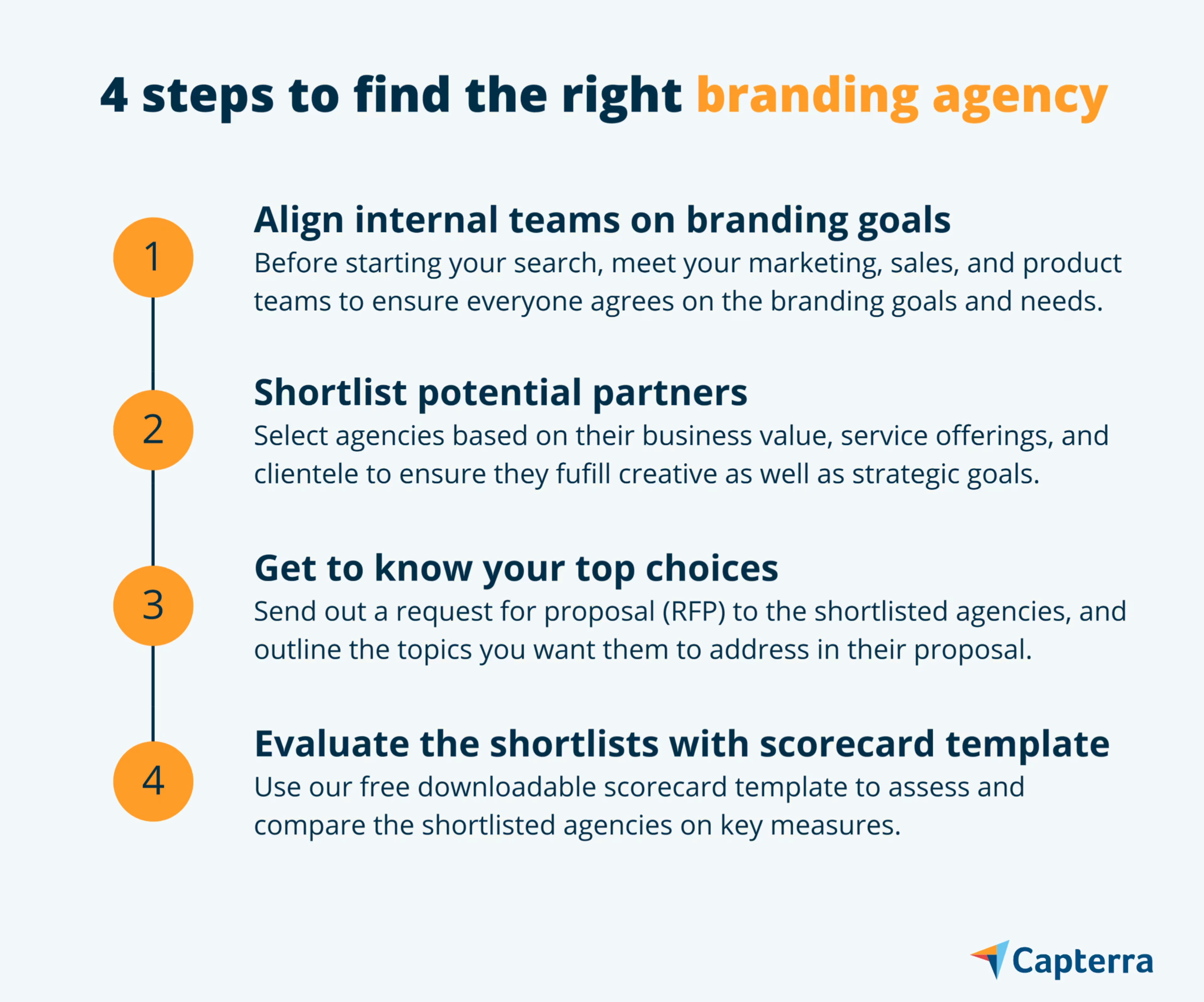Use our free downloadable scorecard template to compare and select the right branding agency for your business.
There are a million branding agencies, and each claims to offer solutions to the branding needs of all types of businesses. Also, most agencies have comparable services and audience reach. Such an overabundance of options can make it hard for marketers to navigate this market.
If you’re a marketing leader at a growing company and wondering if hiring a branding agency would benefit your business, the answer is yes, but there’s a caveat: You have to choose the right one.
Get the decision right, and together you and your partnering agency can rise to new heights. Choose the wrong branding partner, and that could lead to wasted resources, lost time, and, in worst cases, tarnished public image.
To select the right branding agency, you need to establish clear shortlisting criteria. In this article, we look at four steps to assess potential branding partners and choose the right fit. We’ve also included a free downloadable scorecard to help compare your top choices and evaluate them.

Narrow your search for a branding agency with our list of companies in the following areas:
Step #1. Align internal teams on branding goals
Before starting your search for a branding partner, make sure your internal teams are on the same page about the branding goals, budget, and partner needs. Get your digital marketing, sales, and product teams together to ensure consensus on the:
Desired timeline
Branding budget
Technology considerations
Vision for an ideal branding partner—i.e., the capabilities you’re looking for (creative, market research, etc.)
The branding agency landscape, once full of graphic designing and creative agencies, has now evolved. It involves new players offering technology, data-driven, and strategic services with multiple teams involved in the branding process.
Also, a brand inherently comprises several business functions, such as product development, sales, and marketing. This makes it important to align different stakeholders from the beginning to avoid clashes later. Your digital marketing and product engineering teams, for instance, may have different goals and different views on what the brand identity should be or which demographic groups you should target.
Step #2. Shortlist potential branding partners
Once you’ve clearly articulated your needs and brought your teams on the same page, start evaluating agencies based on three factors: values, services, and clientele. Following this process will help your small business shortlist potential partners keeping in mind the creative as well as strategic needs of building a brand strategy.
Values: Does the agency stand for something?
Consumers and businesses are increasingly focusing on values such as inclusion. In line, branding agencies are also incorporating these principles in their culture.
You can benefit from partnering with a brand agency that cares for causes similar to the ones your small business advocates. If you stand for green packaging, for instance, a branding agency that’s vocal about environmental issues can understand your needs much better.
What you should look for
Check how an agency brands itself, the awards it has won, and the aspects of corporate social responsibility it takes pride in. Strong agencies are able to articulate how they balance both business and social appeals.
A red flag is when an agency’s social or political views don’t match your business’s core values.
Services: Does the agency cover critical branding functions?
You may need help with your brand in a particular area right now, but you should also focus on building a relationship with the branding company for the long haul. Assess if the agency is capable of meeting not only your short-term branding needs but also your long-term requirements.
If you’re looking to redesign your logo, for instance, look for an agency that can go deeper into the brand identity to develop guidelines for how your brand is experienced, including creating a new brand strategy, voice, tone, and personality.
What you should look for
Look at the spectrum of services an agency offers, its team composition, and its branding service portfolio. Strong agencies will boast of high-level creative skills and resources, have an understanding of the customer journey, and have the business acumen to give sound strategic suggestions.
A red flag is when an agency describes the branding strategy only as visual designing and approaches it as a logo designing or naming service.
Clientele: Does the agency serve a niche market?
Many brand consulting firms cater to a specific type of clientele, which could be by industry vertical or business maturity. For example, some branding agencies don’t take up projects that are in the business pre-launch phase, while others specialize only in pre-launch branding.
What you should look for
Check the industries and business sizes an agency typically works with. Strong agencies will have experience in targeting demographics and business sizes similar to yours.
A red flag is when a brand agency is associated with a competitor or works with industries you don’t want to link your business with, say tobacco or gambling.
Step #3. Send a request for proposal to your top choices
Once you shortlist the agencies you’re interested in, it’s time to get to know them better. Send out a request for proposal (RFP) to do that.
An RFP is a document that describes the branding project, introduces your company, establishes the type of agency and services you seek, outlines what you hope to accomplish, and asks agencies to submit their bids and proposals for the project.
Remember that good agencies tend to turn down business more often than they pursue. Use this stage to get the agencies excited about working with you.
Here's what you can ask in the RFP:
Agency background
Services and capabilities
Case studies and relevant experience
Summary of the approach to your project
Project staffing
Account management
Proposed schedule
Proposed pricing and fees
Client references
For each section, clearly describe what you expect. If required, you can add a numbered list of questions (or topics) you want them to address.
Bonus tip: When drafting an RFP, emphasize your goals and branding challenge—not how to fix them. That is for the agency to address. This is an opportunity for you to see their capabilities and unique approaches to your business challenges.
Step #4. Evaluate the shortlisted agencies (use our free scorecard template)
Once you complete step 3 and receive proposals, you’ll have all the information you need to evaluate the agencies. Use our free scorecard template to assess the proposals.
We’ve prefilled the template. All you need to do is change the scores for the agency under evaluation, and the template will automatically calculate the overall score.
We’ve created two scorecard tools, one for evaluating a new branding agency and another for assessing the performance of your existing agency.
We’ve used a 4-point scale in the new branding agency scorecard template to ensure your selection isn’t left in limbo. The result will be either the upper half (i.e., the agency exceeds or meets all expectations) or lower half (i.e., the agency meets only some or doesn’t meet expectations). This will make the comparison between multiple agencies more decisive.
How to use our free downloadable scorecard template
Select the “New Agency Scorecard” sheet to evaluate a new firm and the “Existing Agency Scorecard” sheet to evaluate a branding company you’re already working with.
Add the branding agency’s name and date of evaluation.
Use the scoring criteria on the top right to score an agency on various attributes. Enter your scores in column D.
The template will automatically average the scores entered by you, and based on the weightages assigned to different attributes, it will compute a total score (row 4, column C).
You can customize this scorecard by editing the elements (attributes and measures) you want to measure and changing the weightage assigned to them.
Like some agencies? Try them out
After you’ve completed all four steps, invite the agencies that have scored the most on your scorecard for a live demo and presentation. If you find them as good as their proposal, congratulations! You’ll have potential branding partners who could be a good fit. Begin contract negotiations with your favorite.
